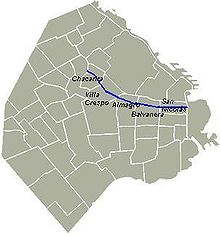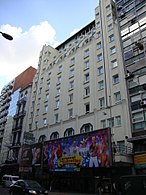Avenida Corrientes

Avenida Corrientes (English: Corrientes Avenue) is one of the principal thoroughfares of the
It extends 69 blocks from Eduardo Madero Avenue in the eastern
The Asociación Amigos de la Calle Corrientes ("Friends of Corrientes Street Association") is a group that collaborates on the urban planning of the street. They have placed commemorative plaques on 40 street corners bearing the distinguished figures from the history of the tango.
History



It was named Del Sol during the 17th century, San Nicolás from 1738 to 1808, and De Incháurregui from 1808 until 1822, when it received its current name. Never more than a street of average width during the nineteenth century, traffic swelled after the city began its rapid westward expansion, around 1880. Horse-drawn tramways first ran on the avenue in 1887; but, they soon proved inadequate and in 1910, Mayor Joaquín de Anchorena signed a bill authorizing its widening.
The plan called for the massive razing of most of the avenue's north-side real estate and, so, met with strenuous opposition from affected landlords, retailers, as well as intellectuals like Roberto Arlt. A coup d'ètat in 1930, however, made way for the plan's implementation, carried out relentlessly until its completion, in 1936. Today, when referring to Corrientes prior to the widening, the term "Narrow Corrientes" (Corrientes Angosta) is still used. Also the name "Corrientes Street" (calle Corrientes) is often preferred over the correct "Corrientes Avenue" (avenida Corrientes) specially on the famous centrical stretch (with that name it appears famously in several tango lyrics, see below).
The newly inaugurated avenue coincided with the construction of the
The first few blocks (from Leandro N. Alem to
Nightlife
For most of the 20th century "Calle Corrientes" was a symbol of
Throughout the decades the street has seen its own fauna of urban stereotypes, from the "innocent
The emergence of video, the Internet, cineplex and shopping malls reduced much of the allure of Corrientes, and saw the closing of several famous cinemas and theatres.[7] Yet sidewalks were widened and beautified in 2005 to facilitate retail activity along the avenue, which had declined since the 1970s.[8] and today Corrientes is once again thriving at night - specially among theatre goers, with several major playhouse renovations and additions. Since the '80s the trend towards world-famous Broadway musicals in Spanish coexists with the more traditional or avant-garde serious theatre and the popular Teatro de Revistas. The last blocks of this main stretch, between Avenida Callao and Uruguay Street are converted into an expansive outdoor reading room during Bookstore Night, an annual event inaugurated in 2007.[9]
Mayor Mauricio Macri announced in 2010 that the financial district section of Corrientes - between Ninth of July and Avenida Leandro N. Alem, would become a two-way avenue.[10]
Points of interest
Base to obelisk
- Luna Park, former boxingring, currently used for other sports and entertainment events
- The back of the Buenos Aires Central Post Office
- Comega Building
- The downtown microcentro banking district ("La City")
- Pedestrian Florida Street
- Teatro Gran Rex
- Teatro Opera
- Many of the country's most important theater companies.
- Numerous traditional and historical restaurants, including Argentine cuisine, Spanish cuisine and Italian cuisine.
- The 9 de Julio Avenue and the Plaza de la República.
“The street that never sleeps”
- Heladería Cadore ice cream shop.
- Los Inmortales pizzeria, previously the Café de los inmortales, ("Café of the immortals") with photos of the historic figures that visited it.
- Güerrín pizzeria
- Café La Paz, historic meeting place for leftist activists and intellectuals
- Bar Ramos
- La Giralda Cafeteria, serving Spanish-style hot chocolate and churros
- Colon Theatre)
- Teatro Broadway
- Paseo La Plaza, an urban oasis with theaters, retail stores and restaurants
- Hernández, Liberarte, and many other famous bookstores
Off-Corrientes
"Off-Corrientes" refers to the alternative playhouse scene, much of it literally concentrated on surrounding streets – although also widely distributed elsewhere in city neighbourhoods. The Rojas Cultural Center of the University of Buenos Aires, which promotes experimental art, and like-minded venues such as Gandhi and Liberarte (which blend bookstore and cultural centre) although catering to "off-Corrientes" crowds, are themselves located on Corrientes.

Once
Further down, Corrientes traverses the
).Abasto
Beyond Pueyrredón Avenue is the neighbourhood of
Almagro

Further down Corrientes is
Villa Crespo
Chacarita
Corrientes ends at the
-
Corrientes Avenue at night
-
The Broadway Theatre. Corrientes Avenue has long been Buenos Aires' Broadway.
-
Abasto shopping center. The city's wholesale market until 1984, investor George Soroshad it converted in 1998.
-
Intersection with upscaleCallao Avenue
Corrientes in tango music
Corrientes Avenue is featured in several tango lyrics, notably:
- A media luz by Carlos Lenzi and Edgardo Donatto
- Calle Corrientes by Alberto Vaccarezza and Enrique Delfino
- Corrientes angosta by Ángel "Pocho" Gatti
- Corrientes y Esmeralda by Celedonio Flores and Francisco Pracánico
- Tristezas de la calle Corrientes by Homero Expósito and Domingo Federico, 1942
- Pucherito de gallina
- Café Dominguez
References
- ^ "Corrientes Avenue Never Sleeps - Buenos Aires". Welcome Argentina. Retrieved 2021-05-19.
- ^ "Buenos Aires, Latin America's theatre capital".
- ISBN 978-1-4053-8642-5.
- ^ Uki Goñi (June 19, 2015). "A novel oasis: why Argentina is the bookshop capital of the world". The Guardian.
- ^ Lillo Montalto Monella (March 28, 2012). "Top 5 Pizzerias". The Argentina Independent.
- ^ Archived at Ghostarchive and the Wayback Machine: "Moscato, Pizza y Fainá - Memphis la blusera En Vivo". YouTube.
- ISBN 978-1-84162-351-1.
- ^ "La avenida Corrientes pierde un carril". La Nación.
- ^ "La avenida Corrientes, un gran escenario literario". Clarín.
- ^ "Avenida de Mayo y Corrientes serán doble mano antes de fin de año". Infobae.
External links
![]() Media related to Avenida Corrientes at Wikimedia Commons
Media related to Avenida Corrientes at Wikimedia Commons




